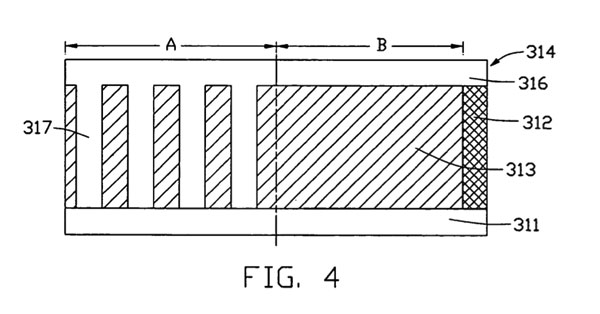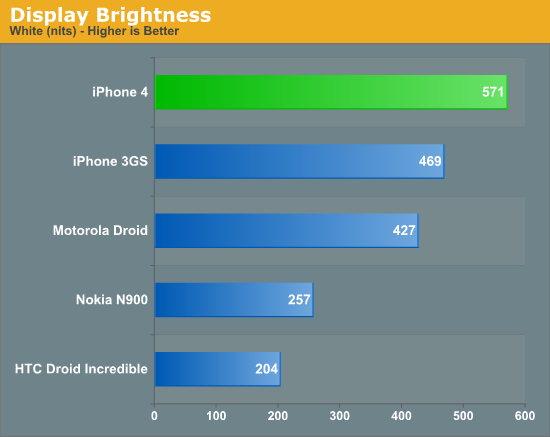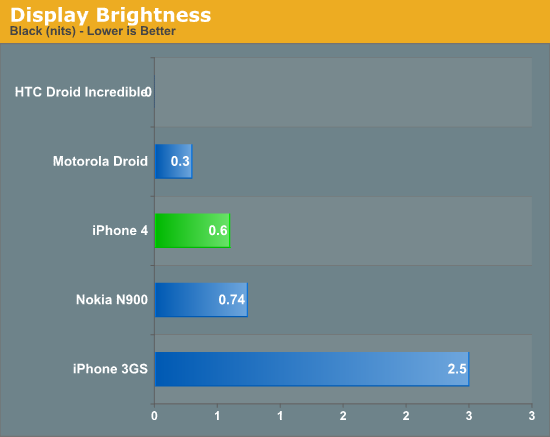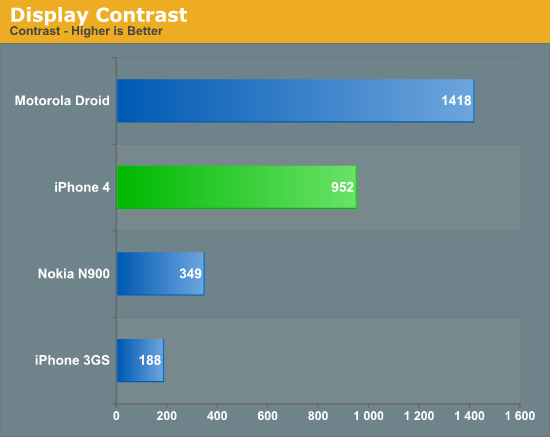Apple's iPhone 4: Thoroughly Reviewed
by Brian Klug & Anand Lal Shimpi on June 30, 2010 4:06 AM EST- Posted in
- Smartphones
- Apple
- iPhone 4
- Gadgets
- Mobile
More Display
It's obvious how Apple settled on 960x640; it's four times the resolution of the previous iPhones. However, instead of decreasing text size, iOS 4 scales appropriately, and the size of everything remains the same. The result is that there are small details everywhere that pop out. Apple's icons on the home screen are the first that really pop out, and new iOS 4 optimized applications will bring that increased detail as developers add higher resolution artwork.
The display panel itself uses a subset of IPS (In Plane Switching) display technology called Fringe Field Switching (FFS). Where IPS switches the crystal polarization in the plane of the display with two opposing electrical substrates composed of semi opaque metals (which decreases transmission and viewing angles), FFS uses considerably less metal by arranging the electrodes in a comb like structure.

See that - it almost looks like a comb. Or an impulse train. Or Dirac comb. So many combs.
The result is that there's considerably less metal in back and in front of the pixel, resulting in much higher transmission of light through the display, and higher brightness for a given backlight level. Using FFS to drive pixel switching is critical here because of the high dot pitch in the iPhone 4's display.
The other interesting difference between iPhone 4's retina display and previous displays is that the digitizer is in optical contact with the display itself. There's no longer an air gap, and as a result, no longer any opportunity for dust to gradually work its way inbetween. Over time, I've noticed a few dust specks creep in on my 3GS, it does happen. The digitizer and display panel are essentially laminated together. The added benefit is that fewer material interfaces results in fewer internal reflections - think the "super" in Super AMOLED but applied to TFT. That's what Apple has done here.
Apple is using Corning's Gorilla glass which touts hugely increased scratch resistance and robustness. Both the front and back of the iPhone 4 are that same type of glass. I've noticed a few superficial scratches (called sleeks) that have appeared on the back, but really the true test will be how the phone looks after 6 months in the pocket. It's interesting that the iPhone capacity markings have disappeared from the back of the phone - no doubt this was done so Apple could make one part and one part only for each color.
The rest of the details are in the specifications. Apple advertises increased brightness of 500 nits and a contrast ratio of 800:1. We measured, and our iPhone 4 exceeded specs at 571 nits and just under 1000:1 contrast ratio.



Note that the HTC EVO 4G is missing as Anand has it, but it's on its way to me. As soon as I get it, I'll measure display brightness, black point, and contrast and update these results. In addition, the HTC Droid Incredible (and thus Nexus One) contrast is effectively infinity by the way we calculate, due to pixels being completely turned off in the black state. In addition, I'm led to believe that the AMOLED's PenTile grid throws off our numbers when measuring brightness. I've run and rerun this test, it keeps coming up that way.
Next to the iPhone 4, the 3GS display really shows its age. It leaks light when displaying black, with an absurdly high black point of nearly 3 nits. Just looking at the lock screen on the iPhone 4 next to the 3GS it's readily apparent how much better blacks are. iPhone 4 easily bests the 3GS but still isn't quite as contrasty as the Incredible or Nexus One AMOLED displays, or the IPS in the Motorola Droid. You do get higher resolution and brightness, however, but nothing is free.
Going from the iPhone 4's display back to the 3GS is pretty painful, but going back to even relatively high dot pitch displays on the desktop is painful as well. Even on the "high resolution" MacBook Pro with 1680x1050 display, displaying an iPhone 4 screenshot at native resolution uses up 91% of the height. If there's one thing I hope the iPhone 4 display does, it's generate demand for 300 PPI level desktop displays - the era of 110 PPI displays being the norm needs to end now.










270 Comments
View All Comments
Mike Wadner - Saturday, July 3, 2010 - link
Well then you're in pretty bad shape. Anyone who considers Microsoft not far behind Apple has their head up their F**KING ass. May be a nice review but I have doubts about their overall knowledge of whats going on out there.websitetrafficchecker - Wednesday, February 5, 2020 - link
If you want to check website traffic for free, visit https://seowebsitetraffic.net/check-website-traffi...jorpoka - Wednesday, June 30, 2010 - link
People seem to making a big deal about the increased ram in iPhone 4, but I think it was almost required.The graphics chip shares memory with the system (just like in previous models) so you have to consider the fact that the screen resolution has increased by 4. How is the system going to deal with the higher resolution grahpics... the 512 MB of ram.
For now not every application on app store uses the updated resolution, but as more and more apps are updated for iOS 4 and the retina display i think the additional 256 MB ram benefit will decrease.
solipsism - Wednesday, June 30, 2010 - link
The surprise wasn't that 512MB wasn't deemed needed, it was simply unexpected after the iPad with a higher resolution, faster processor and generally higher chance for more complex apps to run on the 8x larger display only being shipped with 256MB, like the 3GS, when 512MB was expected. On other words, if the iPad didn't get 512MB RAM, few expected the iPhone 4 being shipped just a couple month later to get it.John Sawyer - Thursday, July 1, 2010 - link
Not higher resolution on the iPad, but more pixels (but we get your meaning).Snotling - Thursday, July 1, 2010 - link
that's the point I'm trying to make since the iPad's release... it was not a planned product, it was ruched out just so they would not be assassinated by the press and the fanatics, my full conspiracy theory is on my blog:http://cyberpeste.blogspot.com/2010/01/letter-to-s...
Now with the iPhone 4, we see what Apple was actually working on before rushing out the iPad and its a very good product. superior in every way to the iPad.
tkoyah - Sunday, July 4, 2010 - link
Um, the iPad wasn't rushed. The iPad project actually pre-dated that of the iPhone. But when it became aparent that this would be the perfect interface for a Phone, the iPhone project began, and was given a higher priority.I expect this first iPad wasn't given more RAM: a) to keep the price-point under $500 b) because there was no pre-existing iPad software, so having less memory available wouldn't break any apps.
tipoo - Wednesday, June 30, 2010 - link
The big deal is that the iPad, their tablet, has half the RAM of the phone they released shortly after. With a bigger screen and more pixels, people naturally would have expected the iPad to have the technological edge, but with only half the RAM of the iPhone that is not the case.AMDJunkie - Wednesday, June 30, 2010 - link
Begins after this post.Zokudu - Wednesday, June 30, 2010 - link
Wonderfully written article I love this line of high end smartphone articles you guys have been releasing. I love the quality of the writing at Anandtech.Just a few questions I have.
Doesn't AT&T have a 5 year exclusivity deal for the iPhone meaning they would still have around 2 years remaining before an opposing carrier could offer the device?
Also several of my friends with iPhones both 3G and 3GS constantly complained about AT&Ts coverage within New York and blamed the carrier. However several of them have gotten iPhone 4's and are reported fewer dropped calls if any at all. I have been using a Blackberry on AT&T's network for several years now and have had no issues with their coverage. Do you feel the dropped calls within hot spots such as New York should be blamed on the iPhone itself or the network?
Also where do you feel that Windows Phone 7 fits into the future of smartphones. Do you envision it taking center stage against both iOS4 and Android or falling to the wayside such as webOS ended up doing?
Once again thank you for the wonderful read and keep up the quality work.